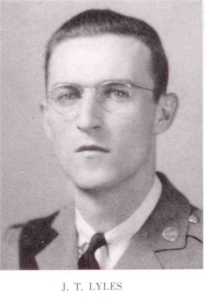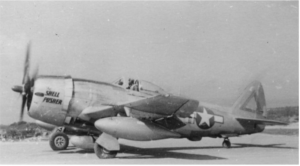Scroll of Honor – John Thomas Lyles, Jr.
Lost to the Pacific
Written by: Kelly Durham
The 507th Fighter Group deployed to the Pacific theater of operations in March 1945. Its planned  mission was to provide fighter escort for the Army Air Force’s new B-29 Superfortress very heavy bombers, the most expensive weapons system ever developed up to that time. Among the group’s pilots was Captain John Thomas Lyles, Jr., Clemson College Class of 1939.
mission was to provide fighter escort for the Army Air Force’s new B-29 Superfortress very heavy bombers, the most expensive weapons system ever developed up to that time. Among the group’s pilots was Captain John Thomas Lyles, Jr., Clemson College Class of 1939.
Lyles was a Newberry native and general science major. At Clemson, he was a member of Sigma Epsilon, a social fraternal organization. As a senior, he attained the rank of cadet second lieutenant.
A year after graduating with a Bachelor of Science degree, Lyles volunteered for Army service. He initially served as an instructor with the 29th Infantry Division at Fort Benning, Georgia. In January 1942, just after the Pearl Harbor attack landed the United States in the middle of the world war, Lyles volunteered for the Army Air Force. He received his wings on August 5, 1942 at Fort Moultrie, Georgia and was designated to fly fighter aircraft.
Lyles was assigned to the 463rd Fighter Squadron of the 507th Fighter Group, flying the rugged P-47 Thunderbolt fighter. In March 1945, the group headed for the wide expanses of the Pacific Ocean, where Allied forces, led by the United States, were slowly pushing the Japanese back from their island-based defensive perimeter toward Japan’s home islands.
With the capture of the Mariana Islands the previous summer,  Army Air Force leaders moved quickly to establish operating bases from which B-29 bombers could launch air strikes against Japan’s major cities and production centers. Previous attempts to conduct raids from airbases in China had been hampered by the difficulty of supplying operations by airborne logistics. Since Allied forces did not at the time control the Chinese coast, all fuel, spare parts, rations, ordnance, and personnel had to be flown in from the west, over the Himalaya Mountains. The logistics proved impractical and so General Hap Arnold, chief of the Army Air Force, looked for island bases in the Pacific that were close enough to Japan to accommodate the B-29’s 1,600 mile operating radius. The first of these were established on Guam, Saipan, and Tinian, but Arnold intended to expand the use of his B-29s moving their bases ever closer as Allied forces tightened the noose around Japan.
Army Air Force leaders moved quickly to establish operating bases from which B-29 bombers could launch air strikes against Japan’s major cities and production centers. Previous attempts to conduct raids from airbases in China had been hampered by the difficulty of supplying operations by airborne logistics. Since Allied forces did not at the time control the Chinese coast, all fuel, spare parts, rations, ordnance, and personnel had to be flown in from the west, over the Himalaya Mountains. The logistics proved impractical and so General Hap Arnold, chief of the Army Air Force, looked for island bases in the Pacific that were close enough to Japan to accommodate the B-29’s 1,600 mile operating radius. The first of these were established on Guam, Saipan, and Tinian, but Arnold intended to expand the use of his B-29s moving their bases ever closer as Allied forces tightened the noose around Japan.
Unlike the smaller, slower B-17s and B-24s flown in the European theater, the Superfortress featured a pressurized cabin, automated fire control systems, heavier bomb loads, and longer range. Even with these advantages, the bombers still needed protection against Japanese fighters. The 507th would be tasked with flying these escort missions once Army and Marine forces captured Okinawa and new bases for the B-29s were established there.
Even before the conquest of Okinawa was complete, the 507th was conducting training and test flights from airfields in the Marshall Islands. On an altitude test flight on May 20, 1945, Captain Lyles and his wingman climbed to 30,000 feet above Eniwetok Atoll. At that point, the wingman lost contact with Lyles. Neither Lyles’s aircraft nor his body were recovered. He was listed as missing and a year later, on May 21, 1945, was declared dead by the War Department.
Lyles was survived by his wife, the former Kathryn Crawford of Columbia, his parents, and one brother.
For more information about Captain John Thomas Lyles, Jr. see:
https://soh.alumni.clemson.edu/scroll/john-thomas-lyles-jr/
For additional information about Clemson University’s Scroll of Honor visit:
https://soh.alumni.clemson.edu/
